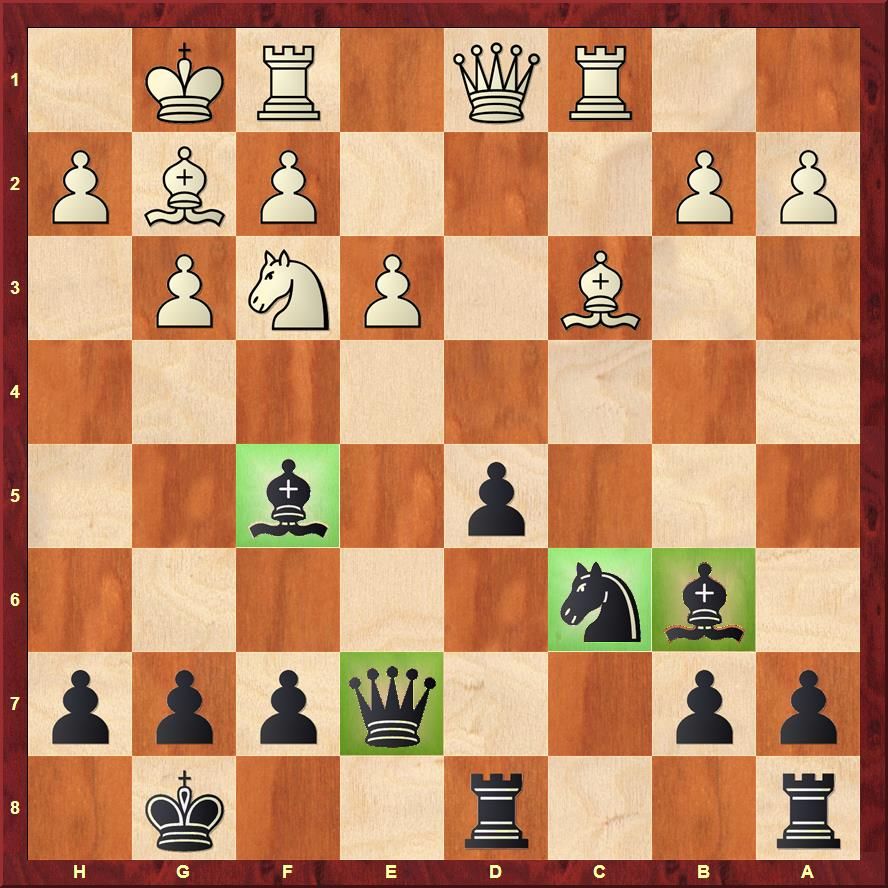Two rounds to go, Anand within striking distance!
Vishy Anand began the Sinquefield Cup with 2.0/3. In the next four rounds he played out four draws against Ding Liren, Wesley So, Anish Giri and Levon Aronian. But none of the games were dull. All of them had something to learn from. We bring to you the critical moments of these four games along with analysis which will help you to understand Anand's play. Have a look at the analysis and also enjoy some beautiful images from the event.
Pictures from the Flickr account of Grand Chess Tour
In our previous article from round three at the Sinquefield Cup 2016, we reported that Vishy had spectacularly won against the World number two Maxime Vachier-Lagrave and was leading the tournament with 2.0/3. Four more games have been played and this is how the situation looks after seven rounds.
Standings after seven rounds
Currently Vishy is in the number two spot with 4.0/7. All the four games after round three have been drawn by him. But they were not without interest. Let's have a look at them one by one.
Round four
Ding Liren vs Anand 0.5-0.5
Anand played the opening in not such an ambitious fashion, but after just ten moves he had a completely acceptable position. Although he had the isolated queen pawn Ding could do very little as the black pieces were very active. Nothing spectacular happened and it was a great result for Anand, who drew without any sweat.
 Anand's move ...e6 was unambitious but very solid. The main move is ...Nc7
Anand's move ...e6 was unambitious but very solid. The main move is ...Nc7




[Site "Saint Louis USA"]
[Date "2016.08.08"]
[Round "4.3"]
[White "Ding, Liren"]
[Black "Anand, Viswanathan"]
[Result "1/2-1/2"]
[ECO "A14"]
[WhiteElo "2755"]
[BlackElo "2770"]
[Annotator "Sagar Shah"]
[PlyCount "72"]
[EventDate "2016.08.05"]
but at the same time unambitious.} (6... Nc7 {is by far the main move. Black
intends to follow up with e5 and set up some sort of a Maroczy bind in the
position.}) 7. O-O Be7 8. d4 O-O 9. Nxd5 exd5 10. dxc5 Bxc5 {Athough Black has
the isolated pawn, White cannot blockade it and hence the second player should
be fine here.} 11. Bg5 Qd7 (11... f6 {There was nothing wrong with this but
maybe Anand didn't want to weaken the kingside.}) 12. Rc1 Bb6 13. Bd2 Qe7 14.
Bc3 Rd8 15. e3 Bf5 {This is typical Vishy. He can sense the dynamics of the
position excellently and is not averse to taking on the IQP position.} 16. Re1
Be4 17. Re2 Rd7 18. Rd2 Rad8 19. Qe2 Rd6 20. Rcd1 h6 21. h4 Qe6 22. Nd4 Nxd4
23. Bxd4 Ba5 $1 {Forcing White to create a pawn weakness in his position as
well.} 24. Bc3 Bxc3 25. bxc3 Bxg2 26. Kxg2 Rc8 27. Qf3 Rxc3 28. Rxd5 Rxd5 29.
Rxd5 Rc8 30. Ra5 Qb6 31. Re5 Kf8 32. Qf5 Re8 33. Rxe8+ Kxe8 34. Qe5+ Kf8 35.
Qb8+ Ke7 36. Qe5+ Kf8 {Nothing much happened in the game and a great result
for Vishy who didn't have to sweat even a bit for the half point with the
black pieces.} 1/2-1/2
Round five
Anand vs Wesley So
Anand played the Guioco Piano with the white pieces which was met with a rare line by Wesley. But Anand's preparation was top notch as he blitzed out his moves. Wesley's preparation was even better as he showed a nice opening idea beginning with...





[Site "Saint Louis USA"]
[Date "2016.08.09"]
[Round "5.1"]
[White "Anand, Viswanathan"]
[Black "So, Wesley"]
[Result "1/2-1/2"]
[ECO "C50"]
[WhiteElo "2770"]
[BlackElo "2771"]
[PlyCount "60"]
[EventDate "2016.08.05"]
Ruy Lopez. I don't think so. But anything to avoid the Berlin!} Bc5 4. O-O Nf6
5. d3 O-O 6. c3 d5 7. exd5 Nxd5 8. a4 (8. Re1 {is supposed to be the main move.
}) 8... Nb6 {This has not been played much but has been tried by strong
players like Jakovenko and Hammer.} 9. Bb5 Ne7 $5 {If Black gets to reroute
his knight to g6 he should be completely fine. White has to act immediately.}
10. a5 (10. Nxe5 c6 11. Bc4 Bd6 12. Bf4 Nxc4 13. dxc4 Nf5 $11 {is completely
fine for Black.}) 10... c6 11. axb6 cxb5 12. Rxa7 Rxa7 13. bxa7 Bxa7 14. Nxe5 {
Black's pawn structure has been mangled and he is also a pawn down. But what
he has in return are the two bishops and they help him to equalize here.} Bf5
15. Re1 $146 {This is Anand's novelty over the game Milliet-Hammer which
continued Be3.} (15. Be3 Bb8 16. d4 Ng6 17. Nxg6 hxg6 18. Nd2 Qd6 19. g3 Qd5
20. Re1 $14 {1/2-1/2 (77) Milliet,S (2346)-Hammer,J (2689) Drancy 2016}) 15...
Bb8 16. Na3 b4 $1 {This was not prepared by Anand.} 17. cxb4 Qd5 $1 18. Nec4 (
18. Bf4 Qd4 19. Bg3 Qxb4 $44) 18... Bxd3 19. Rxe7 Bxc4 20. Qxd5 Bxd5 {White
has no advantage and soon the game ends in a draw.} 21. Rd7 Bc6 22. Rd1 Ba4 23.
Rd3 Bc7 24. b3 Bc6 25. f3 Rd8 26. Rxd8+ Bxd8 27. b5 Bd7 28. Kf2 Be7 29. Ke2
Bxa3 30. Bxa3 Bxb5+ {Excellent piece of preparation by Wesley.} 1/2-1/2
Round six
Anish Giri vs Anand
Vishy Anand came dangerously close to losing against Anish Giri, and it was only a blunder at move 40 that saved the Indian from certain defeat. The opening went fine for both players, in a fighting Semi-Tarrasch. The turning point came after 25…Rc4? due to a serious miscalculation. Anand realized it very soon and admitted he was shaken when he did. As much as he tried to recover his equanimity and position, Giri pressed his advantage well, albeit at a serious cost to his time. This ended up being crucial as a near certain win was thrown out the window on move 40 when he blundered with just four seconds left on the clock. After that it was accept the draw or be worse.





[Site "Saint Louis USA"]
[Date "2016.08.11"]
[Round "6.3"]
[White "Giri, Anish"]
[Black "Anand, Viswanathan"]
[Result "1/2-1/2"]
[ECO "A14"]
[WhiteElo "2769"]
[BlackElo "2770"]
[Annotator "Sagar Shah"]
[PlyCount "81"]
[EventDate "2016.08.05"]
confidence on his preparation and repeats the line he played against Ding.} 7.
O-O Be7 8. d4 O-O 9. e4 {Anish plays in ambitious style as compared to the
Chinese player who had take on d5.} Ndb4 (9... Nxc3 10. bxc3 $14) 10. dxc5 (10.
d5 {looks like the critical test of Anand's idea.} exd5 11. exd5 Nd4 12. Nxd4
cxd4 13. a3 $5 {A forcing line.} (13. Qxd4 Nc2 $13) 13... dxc3 14. axb4 Bxb4
15. Qd4 Bd6 (15... Be7 {Can be Anand's new idea.} 16. bxc3 Bf6 17. Qd3 g6 18.
Be4 Re8 $14 {with not such a huge edge for White.}) 16. bxc3 $14 {This is the
position reached in the game between Gulko vs Kramnik. I am not particularly
impressed with the way Black has played the opening and White can surely count
on a solid edge here. Maybe this is what Anand's opponent's will try out
against him in the future rounds,} b6 17. Bf4 Bb7 18. Rfe1 Bc5 19. Qd3 a5 20.
Be4 g6 21. d6 Bxe4 22. Rxe4 g5 23. Be3 Qxd6 24. Qxd6 Bxd6 25. Bxb6 Ra6 {
1/2-1/2 (25) Gulko,B (2595)-Kramnik,V (2715) Riga 1995}) 10... Bxc5 11. e5 Bb6
12. a3 Nd5 13. Qe2 (13. Nxd5 exd5 {With White being unble to blockade d4 this
should be nothing for Black.}) 13... Bd7 14. Rd1 Nxc3 15. bxc3 Qc7 16. a4 Ne7
17. Ng5 Bc6 18. Ba3 Bxg2 19. Kxg2 Bc5 20. Qe4 Ng6 21. Bxc5 Qxc5 22. Nf3 b6 23.
Rd7 Qxc3 24. Rad1 Rac8 (24... h6 $5) 25. Rxa7 Rc4 $6 (25... Rc7 $1 $11) 26. Qb7
Rcc8 {A psychologically difficult move to make, as you are admitting your
mistake, but that is what makes Anand special. He is very pragmatic.} (26...
Nxe5 $4 {was Anand's idea but he would have been lost after} 27. Ra8 $1 g6 (
27... Qxf3+ 28. Qxf3 Nxf3 29. Rdd8 $18) 28. Rxf8+ Kxf8 29. Qb8+ Kg7 30. Qxe5+
$18) (26... Qc2 $1 27. Rd4 Rxd4 28. Nxd4 Nf4+ $1 29. gxf4 Qg6+ 30. Kf1 Qd3+ $11
) 27. Re1 (27. Rd7 $1 Nxe5 (27... Qc6 28. Rxf7 Qxb7 29. Rfxb7 $18) 28. Nxe5
Qxe5 29. Rxf7 Rxf7 30. Qxf7+ Kh8 31. Re7 $16 {was Giri's best way to play.})
27... Rb8 28. Qe4 Qc5 29. Rb1 b5 30. Ra5 Qc4 31. Qxc4 bxc4 32. Rxb8 Rxb8 33.
Rc5 Rb4 34. a5 Ra4 35. Nd2 c3 36. Rc8+ Nf8 37. Nb3 g5 38. Rxc3 Ra3 39. Kf3 Ng6
40. Rc8+ $2 (40. Ke3 $1 Nxe5 41. Kd4 Ng6 42. Kc4 $16) 40... Kg7 41. Rc3 (41.
Rc3 Nxe5+ 42. Ke4 Ng4 $11) 1/2-1/2
Round seven
Anand vs Levon Aronian
When you play Aronian with the white pieces and open with 1.e4, you better have a good idea with white, as the Armenian is excellently prepared in the opening. White hardly got anything out of the opening but then Aronian started going wrong. Anand had a bind over the position and his knight sat beautifully on the c5 square attacking the b7 pawn. But one inaccuracy and all his work was lost. The game ended in a tame draw.

Anand went for Na4 in this position trying to keep his dark square bind on the queenside. Instead he should have simply played Rcd1, when the threat is to take on d6. And after Bxc5 Bxc5, the ensuing opposite coloured bishop+ rook endgame is quite in White's favour.

[Site "Saint Louis USA"]
[Date "2016.08.12"]
[Round "7.2"]
[White "Anand, Viswanathan"]
[Black "Aronian, Levon"]
[Result "1/2-1/2"]
[ECO "C53"]
[WhiteElo "2770"]
[BlackElo "2792"]
[Annotator "Sagar Shah"]
[PlyCount "68"]
[EventDate "2016.08.05"]
Ba7 9. h3 Ne7 10. Re1 Ng6 11. Bb3 Re8 12. d4 h6 13. Bc2 c6 14. Nf1 d5 15. Nxe5
Nxe5 16. dxe5 Nxe4 17. Bxe4 dxe4 18. Qxd8 Rxd8 19. Ng3 Bb8 $1 {The bishop is
making excellent use of the diagonals available to it!} 20. Be3 (20. Rxe4 $2
Rd1+ 21. Kh2 Ba7 22. Re2 Be6 $15) 20... Bxe5 21. Nxe4 Bc7 22. a5 Bf5 23. Nc5 {
White has a pull here but the bishop pair compensate for the b7 weakness.} Rab8
24. g4 Bc2 25. Rac1 Bg6 26. b4 Bd6 27. Na4 (27. Rcd1 $1 {was a strong move and
would have given White excellent chances to fight on for an advantage.} Bxc5 (
27... Bc2 28. Rxd6 $1 Rxd6 29. Bf4 Rdd8 30. Bxb8 Rxb8 31. Re7 $18) 28. Bxc5 Bc2
29. Rd4 $16 {This opposite coloured bishop position is extremely favourable
for White as Black is quite tied down.}) 27... f6 28. Ba7 Ra8 29. Bc5 Be5 30.
Nb6 Rab8 31. Nc4 Bf4 32. Be3 Bxe3 33. Rxe3 b5 34. axb6 Bf7 (34... Bf7 35. Na5
Rxb6 36. Re7 Rd3 37. Rc7 $14 {White could play on but most of his earlier edge
is lost.}) 1/2-1/2
After a long article, here are the standings once again (in case you didn't notice it at the top of the report!)





